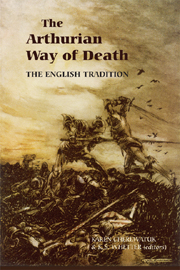Book contents
- Frontmatter
- Contents
- Illustrations and Tables
- Dedication
- List of Contributors
- Introduction
- Part I The early Tradition in england
- Part II Middle English Romance and Malory
- 4 ‘Hadet with an aluisch mon’ and ‘britned to noℨt’: Sir Gawain and the Green Knight, Death, and the Devil
- 5 Love and Death in Arthurian Romance
- 6 Death in the Margins: Dying and Scribal Performance in the Winchester Manuscript
- 7 The Legible Corpses of Le Morte Darthur
- 8 Malory and the Death of Kings: The Politics of Regicide at Salisbury Plain
- 9 ‘Layde to the Colde Erthe’: Death, Arthur's Knights, and Narrative Closure
- Part III Medieval Influence and Modern Arthuriana
- Index
- Arthurian Studies
4 - ‘Hadet with an aluisch mon’ and ‘britned to noℨt’: Sir Gawain and the Green Knight, Death, and the Devil
from Part II - Middle English Romance and Malory
Published online by Cambridge University Press: 12 September 2012
- Frontmatter
- Contents
- Illustrations and Tables
- Dedication
- List of Contributors
- Introduction
- Part I The early Tradition in england
- Part II Middle English Romance and Malory
- 4 ‘Hadet with an aluisch mon’ and ‘britned to noℨt’: Sir Gawain and the Green Knight, Death, and the Devil
- 5 Love and Death in Arthurian Romance
- 6 Death in the Margins: Dying and Scribal Performance in the Winchester Manuscript
- 7 The Legible Corpses of Le Morte Darthur
- 8 Malory and the Death of Kings: The Politics of Regicide at Salisbury Plain
- 9 ‘Layde to the Colde Erthe’: Death, Arthur's Knights, and Narrative Closure
- Part III Medieval Influence and Modern Arthuriana
- Index
- Arthurian Studies
Summary
Until recently, readers of Sir Gawain and the Green Knight (henceforth SGGK) judged Gawain to be a devout Christian whose religion informed the poem's representation of chivalry in definitively medieval ways. Even those who considered Gawain sinful for accepting and then concealing the green girdle regarded Gawain as a good Christian knight. Not surprisingly, this view held sway when the influence of D. W. Robertson and R. E. Kaske was at its height from the 1960s to the 1980s, but it was not at all unique to the so-called ‘exegetical school’ of criticism. J. A. W. Bennett's treatment of SGGK in the Oxford History of English Literature series speaks for this period as a whole: SGGK's ‘story of the testing of Sir Gawain shows how an exemplary knight's piety has been given a deeper, firmer base. … It is this fusion of chivalry, magic, and a firmly-held orthodoxy that gives Gawain its special flavour’ (my emphasis). Comparing him to Chrétien's Perceval, Bennett saw Gawain as ‘a knight compact of all chivalric virtues and boasting the Christian virtues that his blazon denotes, who has yet to face the supreme test of “trawthe”; who fails the test yet, in failing, learns self-knowledge and the most Christian of all virtues – humility’. Bertilak's decree that Gawain was as spiritually clean as a newborn (line 2394) guided this reading of Gawain's performance at the Green Chapel.
- Type
- Chapter
- Information
- The Arthurian Way of DeathThe English Tradition, pp. 73 - 93Publisher: Boydell & BrewerPrint publication year: 2009



